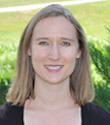Jul 24, 2019
National Program Helps Older Adults in Rural Maine and Hawaii Feel More CAPABLE
by Allee Mead
Learn more about the CAPABLE program in RHIhub's Rural Health Models & Innovations.
Robert* had fallen about 15 times in six months.
A registered nurse, occupational therapist, and home repair technician in Bath, Maine, met with Robert to determine why he was falling so frequently. His shower was the main culprit: With glass doors and a slippery wall, it was difficult to get in and out safely.
The home repair technician replaced the glass doors with a shower curtain and installed grab bars and a tub transfer bench. Thanks to these fixes, Robert has had only one fall and zero trips to the hospital in the last five months.
Robert told Eric Gosselin, Director of Operations at the coordinating healthcare agency CHANS Home Health & Hospice, that showering has been easier since the improvements and assistance from the OT and RN: “I have the tools to work with now.”
People want to be as independent as they can and to be able to continue to do activities that they've always enjoyed, whether it's being able to cook for their family or go to church or be involved in community events.
“People want to be as independent as they can and to be able to continue to do activities that they've always enjoyed, whether it's being able to cook for their family or go to church or be involved in community events,” said Sarah Szanton, PhD, ANP, FAAN, the founder of CAPABLE.
CAPABLE: A National Model
CHANS Home Health & Hospice used the CAPABLE program to help Robert and other clients age safely in their homes. CAPABLE (Community Aging in Place—Advancing Better Living for Elders) is a national model designed by Johns Hopkins University. For five months, a registered nurse (RN), occupational therapist (OT), and home repair technician work with a low-income older adult on lifestyle changes and home modifications that will improve their quality of life.
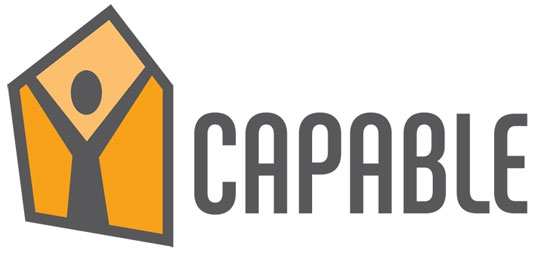
In a traditional model where the focus is often on individual problems instead of a holistic view, a nurse might focus on addressing vital signs, symptoms, and medication management, and an OT might focus on exercises to improve strength, mobility, and balance. While addressing these issues is important to a patient's health, they might not necessarily be important to the patient — or address the underlying causes of the patient's health concerns.
The CAPABLE program takes that desire to improve the patient's health and makes it client-centered. The client sets the goals — anything from exercising more to being able to walk downstairs — and the OT, RN, and handyperson help them meet those goals. The OT makes 4-6 home visits, while the RN visits 3-4 times and the handyperson visits once or twice. The OT helps the client set goals and works with the handyperson to examine the home. The RN assesses any issues the client has with medications, pain, strength, and access to healthcare services.
Gosselin explained why it's important for the client to drive the conversation. If he told a client that she'd benefit from grab bars in the shower, the client might decline, saying that she doesn't need them or doesn't want holes in her wall. Instead, if he asks a client what she'd like to work on, the client might say that she's scared to take a shower because she might slip. Gosselin said he waits until the client asks something like, “What do you think will help?” before suggesting grab bars.
“People tend to believe what they say out loud or what they think,” Gosselin said, “so getting people to think a little differently about what they truly want makes a big difference.”
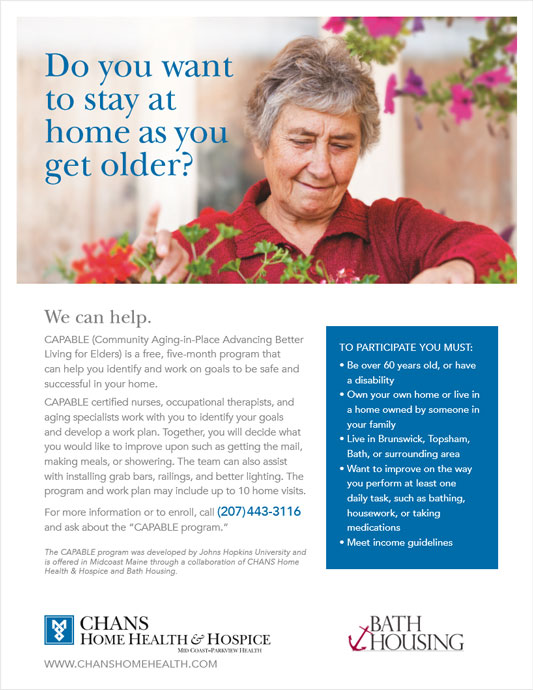
The national CAPABLE model reports a return on investment of over 6 to 1, with over $20,000 in medical costs saved for every $3,000 in program costs. In addition to monetary savings, the program has proven to have a positive impact on clients' ability to function and on their mental health, even reducing depressive symptoms.
Different types of organizations have successfully implemented CAPABLE, including Accountable Care Organizations, Area Agencies on Aging, healthcare systems, nursing homes, and skilled nursing facilities.
CAPABLE has 28 sites in the United States, with three in rural locations: Bath and Fort Fairfield in Maine and the island of Lāna'i, Hawaii. “We'd love for there to be more rural sites,” Szanton said.
The CAPABLE site in Bath serves the coastal area of Maine and partners with Bath Housing, an affordable housing organization, to provide home repairs. Gosselin credits the Bath Housing executive director and the Mid Coast-Parkview Health leadership for getting this CAPABLE site off the ground.
The CAPABLE site in Hawaii serves the rural islands of Lāna'i (population of about 3,100) and Moloka'i (population of about 7,400). This site is run by Nā Pu'uwai, one of five Native Hawaiian Health Care Systems, and is funded through the Native Hawaiian Health Care Improvement Act.
Nā Pu'uwai executive director Kamahanahokulani Farrar learned about CAPABLE two years ago, when she was invited to an event and heard Szanton talk about the program. She went home and created the Kūpuna Aging in Place with Assistance (KAPA) program, modeled after CAPABLE. (One definition of kūpuna is “elder.”)
Small Changes, Big Impact
The CAPABLE program allows staff to make relatively inexpensive changes that aren't offered in a traditional medical model. For example, one client in Maine wanted to cook but couldn't stand in front of the stovetop for long periods of time, so CAPABLE staff bought a stool. Another client didn't want to use the stovetop, so the staff provided a microwave. A third client received a CD rack to remove tripping hazards from the floor.
Some fixes are more labor-intensive. The Maine staff fixed a client's front door, which helped keep the house warmer and safer. Wooden boards in another client's wheelchair ramp had started to rot, so this client was hesitant to go outside. “They were afraid that they would trip, fall, or get hurt just leaving the ramp,” Gosselin said. Home repair technicians replaced the rotten boards so that the ramp was safer.
Another client received home modifications to make it easier to move around in a scooter or wheelchair. One client's laundry room had the light switch on the side of the room opposite the door, so CAPABLE staff installed motion-sensing lights near the entrance.
Some fixes are less tangible. Some clients haven't been to the doctor in so long they feel uncomfortable with the idea of scheduling and getting there. The RN helps these clients practice what they want to discuss with their doctor, schedule the appointment, and set up transportation.
CAPABLE staff in Maine have helped eight clients since April 2018, with everything from exercising to removing tripping hazards. One client loved working on his hobby but hated constantly leaving his projects to use the bathroom, so the staff helped him train his bladder to go less frequently.
KAPA in Hawaii has served three clients in the last year. One client wanted to be able to walk around her yard and water her flowers and other plants, so CAPABLE staff helped her with strength and mobility. The occupational therapist also helped her with car transfers so she can run errands or visit family members. This client told staff she now feels more comfortable, confident, and safe going outside.
It's actually larger than the modifications that we did to your home. It's the modifications that we've helped you achieve just in your community.
Helping seniors become healthier and more mobile helps them stay involved in their community, whether they want to go back to church or volunteer. Farrar said of the program's benefits, “It's actually larger than the modifications that we did to your home. It's the modifications that we've helped you achieve just in your community.”
Because these clients benefit from the companionship as well as the home repairs, Farrar's looking into how she can partner with schools so students can volunteer and earn credits by spending time with these clients. For example, after clients graduate from the KAPA program, students could walk with them around the neighborhood. “People look forward to you coming to visit,” Farrar said.
Making a National Program Local
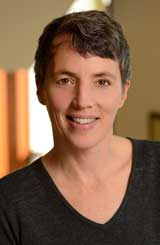
In addition to these fixes, CAPABLE staff assess their clients' goals, their progress, and their readiness for change. The national CAPABLE model created a scale to determine progress; with this scale, a lower score means more improvement. In contrast, the Maine site uses the Patient-Specific Functional Scale, where clients rate their goals throughout different points of the CAPABLE program. With this scale, a higher score means more improvement. Gosselin chose this scale because he uses it in his work as a physical therapist.
In addition, the Maine site adds a home safety check to its services, which the national model does not provide unless specifically requested by the client. For example, Maine's staff offer to do fire safety checks like smoke alarm testing but will not perform these services if the client declines.
In Hawaii, the nurse practitioner incorporates plant medicine and traditional Hawaiian healing into her work as well as speaks Hawaiian with her clients.
While the national model allows some flexibility, certain components — like working with an OT and RN — are needed for programs to count as CAPABLE sites. The national model offers fidelity guidelines so communities can see CAPABLE requirements, “but we're always open to a conversation,” Szanton said. She and her team have talked with communities that weren't able to establish an official CAPABLE site but were still able to create a client-centered program. “We're happy they're inspired by our evidence,” Szanton said.
Challenges to Becoming CAPABLE
One barrier for CAPABLE programs in rural communities is the increased drive time, as clients may live in the country or a site might have to cover a geographically large service area. Szanton remembered talking with a potential CAPABLE site in New Mexico. The site was so isolated that any emergency department visit required a helicopter. While it costs money for CAPABLE nurses to drive to clients' homes, that transportation cost is much cheaper than paying for a helicopter ride. This site is looking to reduce costs even further by replacing some of the home visits with telephone calls or videoconferencing.
The transportation barrier looks different in Hawaii. Neither island in the KAPA service area has regular public transportation. In addition, many supplies need to be flown in or shipped on barges, and some staff members travel from other islands. The program's nurse practitioner flies in from Oahu; she provides home visits on Friday, spends the night on Lāna'i, and works on Saturday before flying back home. The occupational therapist from Maui takes the ferry to Lāna'i to meet with her clients.
The KAPA program also faces the challenge of finding home repair technicians. Farrar originally envisioned working with a volunteer but decided she wanted people who are licensed in their work. Since it can be difficult to find one person who's available for these home modifications, Farrar's working on creating a network of plumbers, electricians, carpenters, and other tradespeople that KAPA staff can call. Many of these clients don't own their homes and are hesitant to contact the landlord about making home modifications, so this arm of the CAPABLE model is limited here. Instead, the staff focus on changes that don't involve any modifications, like purchasing a new walker for a client.
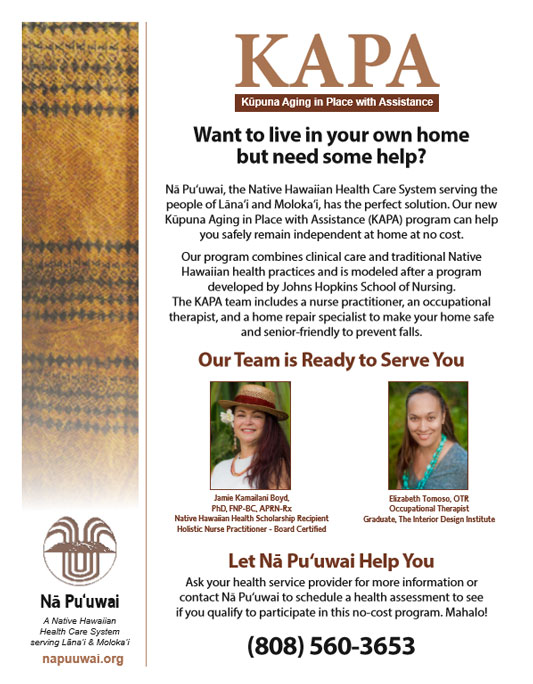
Another barrier is making sure community members know about the program. In Maine, while the Bath site is funded by the Davis Foundations and the local healthcare system to serve 20 clients, it's only served eight so far, with another two waiting to enter the program. Gosselin and others are working on better educating the community about this free service. Bath Housing executive Debora Keller told Gosselin that her Comfortably Home program had a similar slow start, when the community was still learning about its services.
Gosselin also said the slow start could be because of community members' skepticism: “We say it doesn't cost money, but [they might be thinking] how can you have a nurse and an OT come out and not cost money?” Educating people on how the program is funded — and how it differs from home repair programs like Comfortably Home — should help address community members' questions. Gosselin has also learned that informational press releases tend to resonate better with this population than releases that sound like advertisements.
Marketing specifically to medical systems and community organizations has worked, Gosselin said: “Some referrals come from our clinicians who say, 'Hey, I have this patient. Their insurance doesn't pay for a ramp…but I know you guys have this program. I think they meet the guidelines.'” These referrals help the CAPABLE staff learn about and reach out to potential clients. The staff even has a champion in the healthcare system who can help educate healthcare staff and patients about this program.
“This program is kind of a nice adjunct to other medical systems who are trying to do the right thing but don't have the resources.
“This program is kind of a nice adjunct to other medical systems who are trying to do the right thing but don't have the resources,” Gosselin said.
The Hawaii site recruits clients by sending mailers to older adults as well as taking informational packets to physicians' offices. The staff also does press releases and radio spots, including for Hawaii Public Radio. Currently, the staff receives quite a few referrals from the public health nursing staff at the Hawaii State Department of Health.
Lessons Learned
To other rural communities considering CAPABLE, Farrar advised understanding what challenges you may experience and finding community partners. For example, KAPA partners with other traditional healers as well as social workers from the Maui County's Office on Aging.
Gosselin also recommended figuring out many details before launching the program: “You need to know how home repair's going to happen, who's going to do them, how we are going to schedule these things, who's going to get the phone calls from the people calling in, who's going to set up the training for the nurses and the occupational therapists and the home repair technicians.” He said it took his group four or five meetings to figure out these details.
Szanton recommended that any community interested in becoming a CAPABLE site first reach out to other local organizations — the healthcare system, philanthropy groups, and Meals on Wheels, for example — to determine funding sources and then reach out to her and the Johns Hopkins team. This team provides a startup package, with tips on talking to community stakeholders and recruitment strategies.
In addition, this team helps CAPABLE sites as needed, whether sites just need help with OT and RN training or if sites want step-by-step assistance. “We like to work with sites based on their goals and what they want,” Szanton said. “We want to help them succeed because it is a different model, and we view ourselves as lowering the barriers to achieving great outcomes.”
“I can't say enough about Szanton and her program, how they're organized and supportive,” Gosselin said.
While there are challenges to overcome, Farrar and Gosselin have seen how CAPABLE benefits individuals and communities. “Big differences can happen from small changes,” Szanton said.
Additional Resources
The national CAPABLE model's website provides more information on:
- FAQs about program implementation, costs, and staffing considerations
- News, Events, and Publications
- Training

